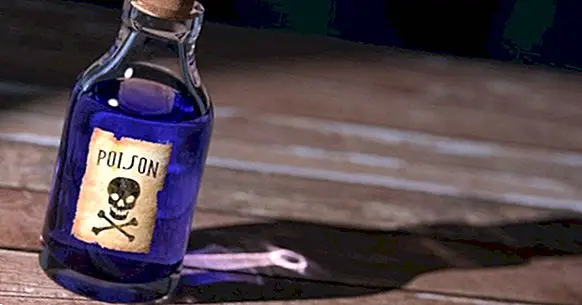Toxicofobia (fear of poisoning): symptoms, causes and treatment
The presence of toxins is not something unusual, poisoning being one of the main reasons for the death of a large number of people throughout history. Poisons such as arsenic were used during antiquity and the average age to commit murders, and even today there are chemical weapons used in wars. We also use poisons to kill the lives of other creatures, such as rat poison or insecticides.
The existence of a certain fear of being poisoned at any given moment can, therefore, be quite rational. But most of us are never going to really get poisoned. Maybe some food poisoning, or produced by drugs, but death by poisoning is not so common. However, for some people, this fear exists persistently and becomes an uncontrollable panic, which leads them to avoid situations and stimuli and greatly limits their lives. This is what happens to those subjects with toxicofobia .
- Related article: "Types of phobias: exploring the disorders of fear"
The toxic phobia as a specific phobia
It is considered toxicofobia, toxifobia or toxophobia al Irrational or exaggerated fear of poison or being poisoned (usually accidentally). It is one of the so-called specific phobias, in which intense fear or anxiety is generated when faced with a specific stimulus. These sensations provoke in those who suffer from the intense need to flee the stimulus, as well as the avoidance of both exposure to it and situations in which it could appear.
This panic is persistent, not disappearing by itself and taking place every time there is an exposure to the stimulus in question. This fear is usually triggered by the presence of the stimulus itself, but the mere imagination or thought about the element causing fear can trigger reactions of anguish and physiological symptoms.
Among the most common symptoms, we find tachycardia, hyperventilation, sweating and tremors, and an anxiety crisis may arise . At the cognitive level, attention is focused on the stimulus and avoiding it, reducing cognitive abilities and judgment and planning capacities. In extreme cases, hallucinations could appear, such as nervous paroxysm, in which they might catch the taste of poison or something toxic in food.
Although seeing and recognizing some type of poison is not usual, the toxicophobia can be a serious limitation for the life of the person who suffers it. If it occurs in a mild degree, a fear may appear towards the poisons themselves, avoiding the use or exposure of poisons such as rat poison. But depending on the degree, this panic can be extended to the consumption of cleaning products, solvents, drugs and practically any type of chemical with harmful potential. It can also generate suspicion towards the manipulation of beverages or food or, in extreme cases, towards contact with other people who could poison us.
- Related article: "Intervention in phobias: the technique of the exhibition"
Linkage with other psychopathologies
An interesting aspect of the toxicophobia that is worth noting is its possible linkage or confusion with elements of other psychopathologies and symptoms , such as persecutory delusions or gustatory hallucinations in different conditions and states of psychotic type, such as schizophrenia, delusional disorder or substance poisoning (in this case, we would be talking about actual intoxication). It can also be confused at times with obsessive-compulsive disorder, in those subjects with obsessions linked to germs and with compulsions of cleaning and washing.
In this sense, it should be noted that the toxic phobia supposes a disproportionate fear of the idea of being poisoned or the presence of poisons and can lead to the avoidance of situations in which there may be toxic elements or the perception of a high possibility of being poisoned.
The disproportionate fear of being poisoned is also common in people with persecutory delusions, but in this case we would not be talking only about fear but about the persistent and fixed belief that someone is trying to kill us in this way (Sometimes there are gustatory hallucinations that interpret as confirmation of this belief). Or in people with OCD linked to germs, diseases and cleanliness, the idea that these elements appear can cause deep anxiety.
The idea that they are trying to kill us, the concern about the germs and diseases that they can cause or the thought that some kind of misfortune can happen if we do not perform the compulsion can generate the emergence of a deep aversion and fear of exposure to elements such as poison or toxins, seeking their avoidance through compulsions (although usually cleaning OCD are linked to germs to be cleaned and not toxic chemicals).
However, we must bear in mind that for us to be talking about a phobia it is necessary that the fear be irrational or disproportionate. In these cases, the fear would be consistent with the presence of repetitive and intrusive thoughts linked to the issue or to the belief that someone is really trying to kill us or hurt us.The different diagnostic classifications stipulate in this sense that only a phobia is diagnosed as toxic phobia in the absence of other disorders that better explain fear and reactions to the feared stimulus.
Causes: a fear with adaptive meaning
The causes of the toxicophobia, as it happens with other mental alterations, is not completely known. Despite this, there are several highly plausible hypotheses regarding its origin.
A possible hypothesis is the existence of conditioning: throughout our lives we have been seeing and receiving news of people who have died poisoned, either accidentally or provoked voluntarily. It is even possible that we may have seen or experienced a situation in which we or someone we love has been poisoned. In this sense, the person with toxicofobia could have acquired a fear conditioned by past experiences , be lived in their own flesh or vicariously through the visualization of a case of poisoning (either through direct observation, reading or audiovisual media).
Another hypothesis that is quite plausible is the same one that one usually has towards the fear of different animals and plants: the theory of Seligman's preparation. This theory proposes that intense fear of some stimuli would be prepared phylogenetically, being inherited from our ancestors when they had to face situations of life or death. For example, the attack of a predator, the bite of a spider or the consumption of certain herbs can cause death. In this way, our species would have learned to avoid a series of stimuli and to feel an innate fear or disgust towards them.
Although in the case of the toxic phobia the element in question very generic (in nature we do not find loose poison but this comes from animals or plants), we could be before a generalization of these fears linked to the idea of dying or getting sick because of an external agent not directly visible. Obviously, avoiding toxic elements is adaptive and allows us to survive, so that the fear of being poisoned could be explained to a large extent by this theory.
Treatment of this disorder
One of the most common treatments when fighting phobias is exposure therapy . It is about placing the subject in situations in which he has to face his fear, generally in a graduated way after having carried out a hierarchy with feared situations between terapeta and patient. In the case of toxic phobia, evidently the subject is not going to expose himself to be really poisoned, but it is possible to work with avoided situations related to this fear.
For example, the subject can be exposed to drinking in a group or in a discotheque if this situation generates fear of poisoning the cup. You can also expose yourself to using chemical components such as cleaning products. Another possible item would be to manipulate commonly used vials or poisons, such as insecticides or rat poison.
The discussion of beliefs and fears, as well as the meaning attributed to the poison and the beliefs that may be behind the fear of toxics or being poisoned, can also be useful. Generally, they would be used cognitive-behavioral therapy procedures , like cognitive restructuring.
Also, it is essential to make a good differential diagnosis, due to the high probability of confusing the toxic phobia or being poisoned with the belief of being it own of some subjects with some type of psychotic pathology or the obsession with the cleaning of some types of Obsessive-Compulsive Disorder.
Bibliographic references
- American Psychiatric Association. (2013). Diagnostic and Statistical Manual of Mental Disorders. Fifth edition. DSM-V. Masson, Barcelona.



















